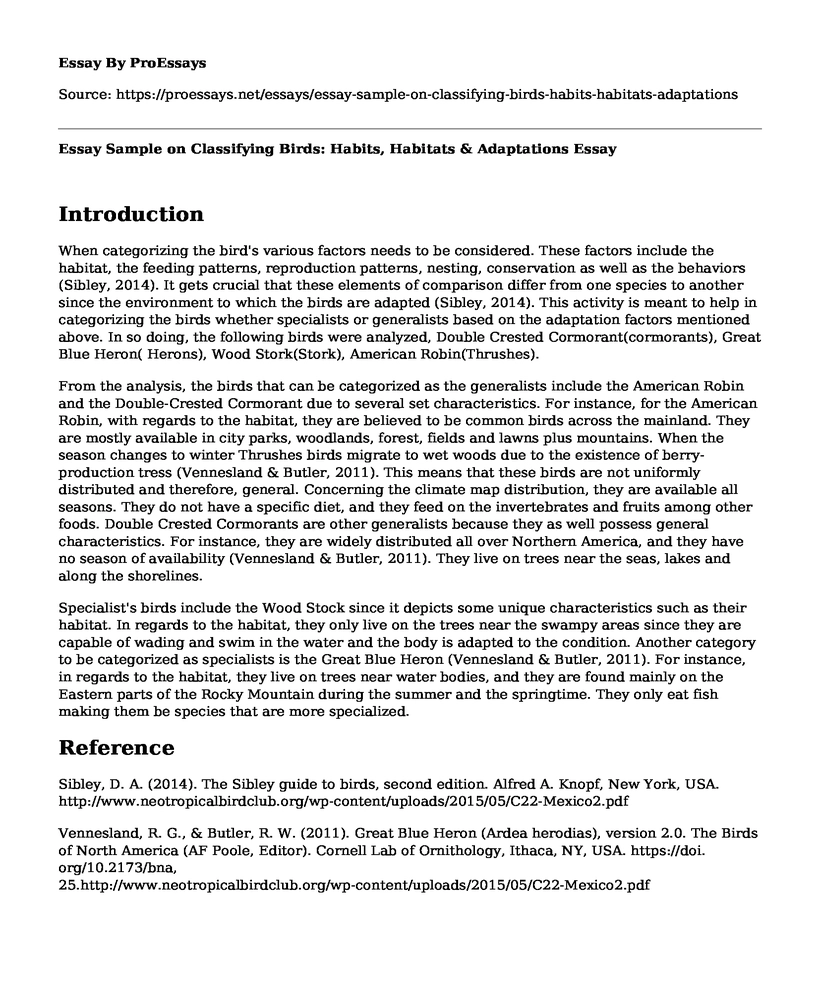Introduction
When categorizing the bird's various factors needs to be considered. These factors include the habitat, the feeding patterns, reproduction patterns, nesting, conservation as well as the behaviors (Sibley, 2014). It gets crucial that these elements of comparison differ from one species to another since the environment to which the birds are adapted (Sibley, 2014). This activity is meant to help in categorizing the birds whether specialists or generalists based on the adaptation factors mentioned above. In so doing, the following birds were analyzed, Double Crested Cormorant(cormorants), Great Blue Heron( Herons), Wood Stork(Stork), American Robin(Thrushes).
From the analysis, the birds that can be categorized as the generalists include the American Robin and the Double-Crested Cormorant due to several set characteristics. For instance, for the American Robin, with regards to the habitat, they are believed to be common birds across the mainland. They are mostly available in city parks, woodlands, forest, fields and lawns plus mountains. When the season changes to winter Thrushes birds migrate to wet woods due to the existence of berry-production tress (Vennesland & Butler, 2011). This means that these birds are not uniformly distributed and therefore, general. Concerning the climate map distribution, they are available all seasons. They do not have a specific diet, and they feed on the invertebrates and fruits among other foods. Double Crested Cormorants are other generalists because they as well possess general characteristics. For instance, they are widely distributed all over Northern America, and they have no season of availability (Vennesland & Butler, 2011). They live on trees near the seas, lakes and along the shorelines.
Specialist's birds include the Wood Stock since it depicts some unique characteristics such as their habitat. In regards to the habitat, they only live on the trees near the swampy areas since they are capable of wading and swim in the water and the body is adapted to the condition. Another category to be categorized as specialists is the Great Blue Heron (Vennesland & Butler, 2011). For instance, in regards to the habitat, they live on trees near water bodies, and they are found mainly on the Eastern parts of the Rocky Mountain during the summer and the springtime. They only eat fish making them be species that are more specialized.
Reference
Sibley, D. A. (2014). The Sibley guide to birds, second edition. Alfred A. Knopf, New York, USA. http://www.neotropicalbirdclub.org/wp-content/uploads/2015/05/C22-Mexico2.pdf
Vennesland, R. G., & Butler, R. W. (2011). Great Blue Heron (Ardea herodias), version 2.0. The Birds of North America (AF Poole, Editor). Cornell Lab of Ornithology, Ithaca, NY, USA. https://doi. org/10.2173/bna, 25.http://www.neotropicalbirdclub.org/wp-content/uploads/2015/05/C22-Mexico2.pdf
Cite this page
Essay Sample on Classifying Birds: Habits, Habitats & Adaptations. (2023, Jan 12). Retrieved from https://proessays.net/essays/essay-sample-on-classifying-birds-habits-habitats-adaptations
If you are the original author of this essay and no longer wish to have it published on the ProEssays website, please click below to request its removal:
- Argumentative Essay: Animal Testing Should Be Forbidden
- Connecting Medical Approaches to the Brain Functions - Essay Sample
- Research Paper on Uniting to Thwart the Worldwide Extinction Crisis
- Essay on Grey Parrots: Psittacus Erithacus - Medium Sized, Black-Billed & Varied Colours
- Essay Sample on Rivers: Dynamic Ecosystems from Headwaters to Mouth
- Cruelty to Animals: The Mental Impact it Causes - Research Paper
- Brain: The Control Center of Our Lives - Essay Sample







